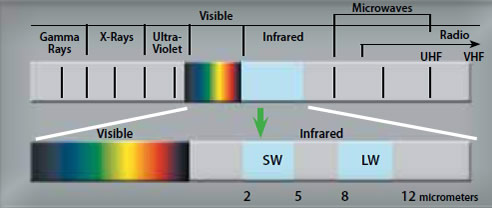NEWS ARTICLE ARCHIVESInfrared Detectors from Flir Systems Australia Infrared - part of the electromagnetic spectrum Our eyes are detectors that are designed to detect visible light (or visible radiation). There are other forms of light (or radiation) that we cannot see. The human eye can only see a very small part of the electromagnetic spectrum. At one end of the spectrum we cannot see ultraviolet light, while at the other end our eyes cannot see infrared. Infrared radiation lies between the visible and microwave portions of the electromagnetic spectrum. The primary source of infrared radiation is heat or thermal radiation. Any object that has a temperature above absolute zero (-273.15 degrees Celsius or 0 Kelvin) emits radiation in the infrared region. Even objects that we think of as being very cold, such as ice cubes, emit infrared radiation. We experience infrared radiation every day. The heat that we feel from sunlight, a fire or a radiator is all infrared. Although our eyes cannot see it, the nerves in our skin can feel it as heat. The warmer the object, the more infrared radiation it emits. The infrared camera Infrared energy (A) coming from an object is focused by the optics (B) onto an infrared detector (C). The detector sends the information to sensor electronics (D) for image processing. The electronics translate the data coming from the detector into an image (E) that can be viewed in the viewfinder or on a standard video monitor or LCD screen. Infrared thermography is the art of transforming an infrared image into a radiometric one, which allows temperature values to be read from the image. In order to do this, complex algorithms are incorporated into the infrared camera. Why would you choose a FLIR thermal imaging camera? There are other technologies available to help you measure temperatures in a non-contact mode. Infrared thermometers for example. Infrared thermometers vs thermal imaging cameras Infrared (IR) thermometers are reliable and very useful for single-spot temperature readings, but, for scanning large areas, it's easy to miss critical parts like air leakages, areas with insufficent insulation or water intrusion. A FLIR thermal imaging camera can scan entire buildings, heating and HVAC installations. It never misses a potential problem area no matter how small this might be. Use thousands of infrared thermometers at the same time with an infrared thermometer you are able to measure the temperature at one single spot. FLIR thermal imaging cameras can measure temperatures on the entire image. The FLIR i3 has an image resolution of 60 x 60 pixels. This means that it is equal to using 3,600 IR thermometers at the same time. If we look at the FLIR T640bx, our top model, which has an image resolution of 640 x 480 pixels, this means 307,200 pixels or using 307,200 infrared thermometers at the same time. Find problems faster and easier with extreme accuracy. It is easy to miss a critical building problem if you are only using a spot IR thermometer. A FLIR thermal imaging camera will give you a total view of the situation and instant diagnostic insights. It not only locates a construction problem in a building but shows the full extent of problems. |
 |
 |